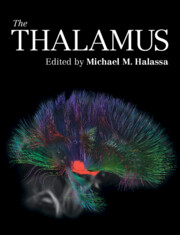Book contents
- The Thalamus
- The Thalamus
- Copyright page
- Contents
- Contributors
- Preface
- Section 1: History
- Section 2: Anatomy
- Section 3: Evolution
- Chapter 5 Morphological, Developmental, and Functional Evolution of the Thalamus
- Chapter 6 Lamprey Thalamus and Beyond
- Section 4: Development
- Section 5: Sensory Processing
- Section 6: Motor Control
- Section 7: Cognition
- Section 8: Arousal
- Section 9: Computation
- Index
- References
Chapter 6 - Lamprey Thalamus and Beyond
from Section 3: - Evolution
Published online by Cambridge University Press: 12 August 2022
- The Thalamus
- The Thalamus
- Copyright page
- Contents
- Contributors
- Preface
- Section 1: History
- Section 2: Anatomy
- Section 3: Evolution
- Chapter 5 Morphological, Developmental, and Functional Evolution of the Thalamus
- Chapter 6 Lamprey Thalamus and Beyond
- Section 4: Development
- Section 5: Sensory Processing
- Section 6: Motor Control
- Section 7: Cognition
- Section 8: Arousal
- Section 9: Computation
- Index
- References
Summary
The lampreys (Cyclostomes) represent the oldest group of now-living vertebrates that diverged from the vertebrate evolutionary line leading to mammals 560 million years ago. It is therefore of particular interest to consider if there is a thalamus similar to that of other vertebrates and examine how it is organised. The lamprey thalamus relays both visual and somatosensory information to the cortex (also called the pallium). In addition, the thalamus receives input from both the optic tectum (superior colliculus) and pretectum, as in other vertebrates, and there is, furthermore, a thalamic projection to the striatum from cells located in the periventricular area of the thalamus. Essentially, the basic compartments of the mammalian thalamus are thus represented in the lamprey but with a much smaller number of neurons. The implication is that the essential features of the thalamus had already evolved at the point when the cyclostome lineage diverged from that leading to other vertebrates. We review here what is known regarding the lamprey thalamus from the perspective of anatomy, transmitters, and neurophysiology and also how it compares to mammals, as well as other groups of vertebrates.
- Type
- Chapter
- Information
- The Thalamus , pp. 125 - 138Publisher: Cambridge University PressPrint publication year: 2022



